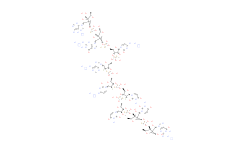MicroRNAs (miRNAs) are a class of small, naturally occurring non-coding RNAs that control post-transcriptional gene expression to regulate cellular functions, development, cell differentiation, and homeostasis. They are about 22 nucleotides long. Since microRNAs control cell differentiation, proliferation, and apoptosis, they are crucial for the development of embryos, cells, and tissues, which explains their significance in human reproduction. Meanwhile, it has been discovered that abnormal miRNA expression or function is closely linked to the occurrence or progression of a number of human diseases, including cancers. MiRNAs are emerging as novel biomolecular targets for chemical-biological studies, including regulation and detection, given their significant roles in physiology and pathology.
The production of miRNAs involves a number of steps. The canonical biogenesis pathway, which produces the majority of miRNAs, involves RNA polymerase II transcription to create a primary transcript (pri-miRNA) and microprocessor complex cleavage to create a hairpin precursor miRNA (pre-miRNA) in the nucleus.Following export into the cytoplasm, the enzyme Dicer cleaves the pre-miRNA to produce a double-stranded RNA duplex. AGO proteins in the RNA-induced silencing complex (RISC) are guided in their binding to the 3' untranslated region (UTR) to either repress protein translation or promote mRNA degradation by the mature miRNA, which is only one strand of the double-stranded RNA duplex.There are non-canonical microprocessor- or Dicer-independent miRNA biogenesis pathways in addition to the canonical miRNA biogenesis pathways. There have been reports of miRNAs promoting gene expression, despite the fact that miRNAs are primarily involved in the down-regulation of gene expression. Furthermore, in a particular cell type, the relationships between miRNAs and their targets are not always 1:1. In actuality, a single miRNA may control a large number of mRNA targets, and vice versa, a single mRNA target may also be controlled by a large number of miRNAs.
| Structure | Cat No. | Product Name | CAS No. | Product Description |
|---|---|---|---|---|

|
V80798 | mmu-let-7j inhibitor | mmu-let-7j inhibitor is a complementary single-stranded mature miRNA whose entire chain has been modified with methoxy groups. | |

|
V81101 | mmu-let-7k agomir | mmu-let-7k agomir is a specially chemically modified miRNA mimic. | |

|
V80799 | mmu-let-7k antagomir | mmu-let-7k antagomir is a complementary single strand of mature miRNA that has been specially chemically modified. | |

|
V80800 | mmu-let-7k inhibitor | mmu-let-7k inhibitor is a complementary single-stranded mature miRNA whose entire chain has been modified with methoxy groups. | |

|
V41156 | MTL-CEBPA (CEBPA-51) | 2862057-05-2 | MTL-CEPBA is a small activating RNA that targets C/EBPα upregulation. |

|
V80851 | MTL-CEBPA sodium (CEBPA-51 sodium) | MTL-CEBPA (sodium) is the sodium salt form of MTL-CEBPA. | |

|
V75507 | Remlarsen (MRG-201) | 1848266-71-6 | Remlarsen (MRG-201) is a miR-29b mimetic that works as a miR-29b agonist. |

|
V38949 | RG-101 (Temavirsen) | 1929655-04-8 | RG-101 is an N-acetylgalactosamine-conjugated oligonucleotide targeting hepatocytes that antagonizes miR-122. |

|
V81293 | RG-101 sodium (Temavirsen sodium) | RG-101 sodium is an N-acetylgalactosamine-conjugated oligonucleotide targeting hepatocytes that antagonizes miR-122. | |

|
V38445 | RGLS4326 (RG4326) | 2229964-07-0 | RGLS4326 (RG4326) is a first-in-class microRNA-17 (miR-17) oligonucleotide inhibitor. |

|
V38326 | RJW100 | 1276664-20-0 | RJW100 is a potent liver receptor homolog 1 (LRH-1, NR5A2) and steroidogenic factor-1 (SF-1, NR5A1) agonist/activator with pEC50s of 6.6 and 7.5, respectively. |

|
V81642 | rno-let-7f-1-3p agomir | rno-let-7f-1-3p agomir is a specially chemically modified miRNA mimic. | |

|
V81319 | rno-let-7f-1-3p antagomir | rno-let-7f-1-3p antagomir is a complementary single-stranded mature miRNA that has been specially chemically modified. | |

|
V81320 | rno-let-7f-1-3p inhibitor | rno-let-7f-1-3p inhibitor is a complementary single-stranded mature miRNA whose entire chain has been modified with methoxy groups. | |

|
V73124 | Skullcapflavone I (Panicolin) | 41060-16-6 | Skullcapflavone I can be extracted from A. nallamalayana. |

|
V15755 | Targapremir-210 (TGP-210) | 1049722-30-6 | Targapremir-210 (TGP-210) is a novel potent and selective inhibitor of microRNA-210 with anticancer activity. |